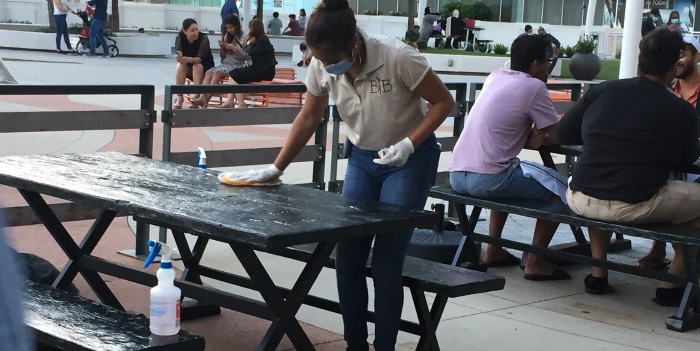National Food Safety Month Week 2: Clean and sanitize right!
 Surfaces that don’t come in contact with food only need to be cleaned and rinsed to prevent dirt from building up. But any surface that touches food has to be cleaned, rinsed, sanitized and left to air-dry.
Surfaces that don’t come in contact with food only need to be cleaned and rinsed to prevent dirt from building up. But any surface that touches food has to be cleaned, rinsed, sanitized and left to air-dry.Food can easily be contaminated if you don’t keep your facility and equipment clean and sanitized. While cleaning removes food and other dirt from a surface, sanitizing reduces the number of pathogens on a surface to safe levels.
Check out these tips for cleaning and sanitizing the right way:
Tip 1: Use cleaners the right way
- Follow the manufacturer’s instructions carefully when using them
- Only use cleaners for their intended purpose. Never use one type of cleaner in place of another unless the intended use is the same.
Tip 2: Use sanitizers the right way
Make sure you mix sanitizers to the right concentration. Sanitizer solution is a mixture of sanitizer and water. The concentration of the mix — the amount of sanitizer to water — is critical. Too little sanitizer and it won’t be effective in reducing pathogens. Too much, and the solution can be unsafe.
- Use a test kit to measure the concentration
- Make sure the water is the right temperature
- Make sure you leave the object in the sanitizing solution for the right amount of time. For a sanitizer solution to kill pathogens, it must make contact with the object being sanitized for a specific amount of time, which can be anywhere from 7-30 seconds depending on the sanitizer and other conditions.
- Change the solution when it looks dirty or its concentration is too low. Hard water, food, and leftover detergent can reduce the solution’s effectiveness
Make the most of your operation’s Food Safety Month experience; visit our resources page to download posters, activity sheets, and more!
Tip 3: Clean and sanitize surfaces correctly
Surfaces that don’t come in contact with food only need to be cleaned and rinsed to prevent dirt from building up. But any surface that touches food has to be cleaned, rinsed, sanitized and left to air-dry. Here’s how:
- Scrape or remove food from the surface
- Wash the surface
- Rinse the surface
- Sanitize the surface
- Allow the surface to air-dry
Tip 4: Clean and sanitize surfaces when required
All food-contact surfaces need to be cleaned and sanitized at these times:
- After they’re used
- Before working with a different type of food
- After handling different raw TCS (time/temperature controlled for safety) fruits and vegetables
- Anytime an employee is interrupted during a task and the items they were using could have been contaminated
- After four hours if the items have been in constant use
Tip 5: Use cleaning cloths the right way
Never use cloths that are meant for wiping food spills for any other purpose.
- Store wet wiping cloths used for wiping prep tables and other equipment surfaces in a sanitizer solution between uses.
- Use dry cloths if you’re using them to wipe food spills from tableware, such as from a plate or utensil during service.
Tip 6: Use foodservice chemicals safely
Only use chemicals that are approved for use in a foodservice operation.
Always cover or remove items that could become contaminated before using chemicals.
After using chemicals, make sure to clean and sanitize equipment and utensils.
When transferring chemicals to a new working container, label the new container with the common name of the chemical.
Store chemicals separately from food and equipment by either:
- Spacing the chemicals apart from these items.
- Partitioning off the chemicals from other items stored in the same area